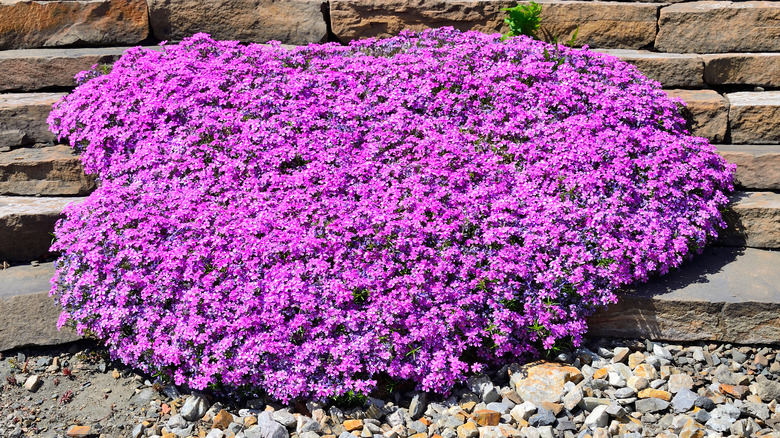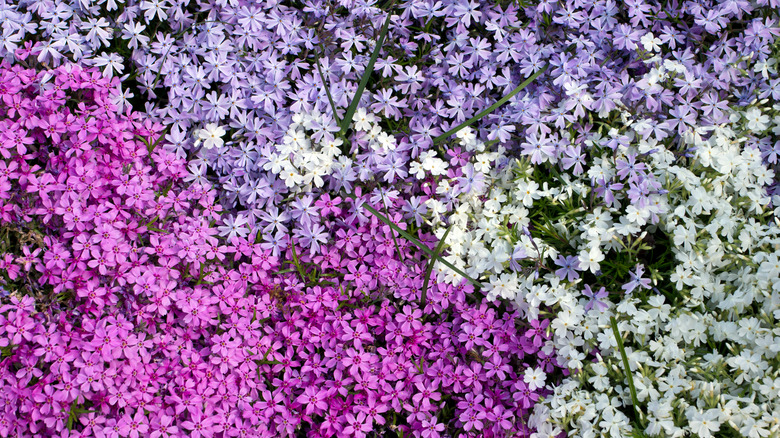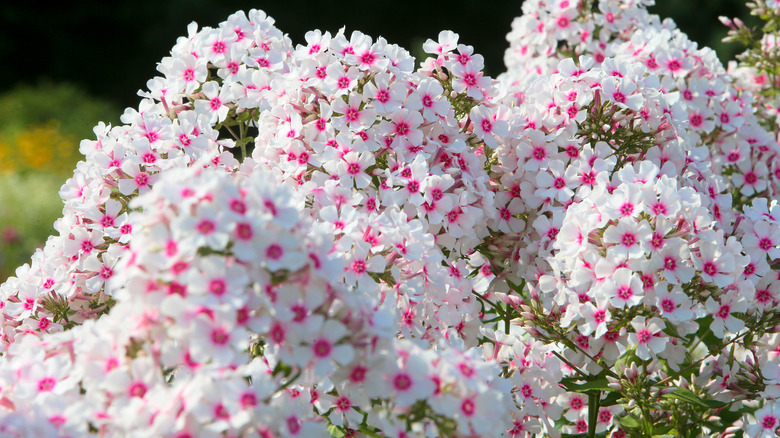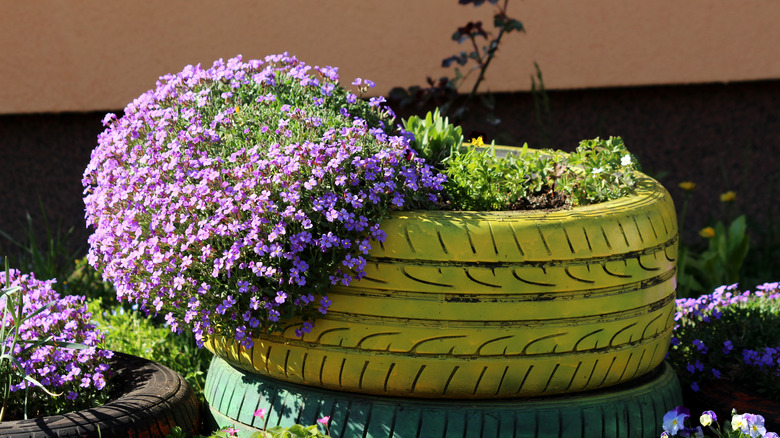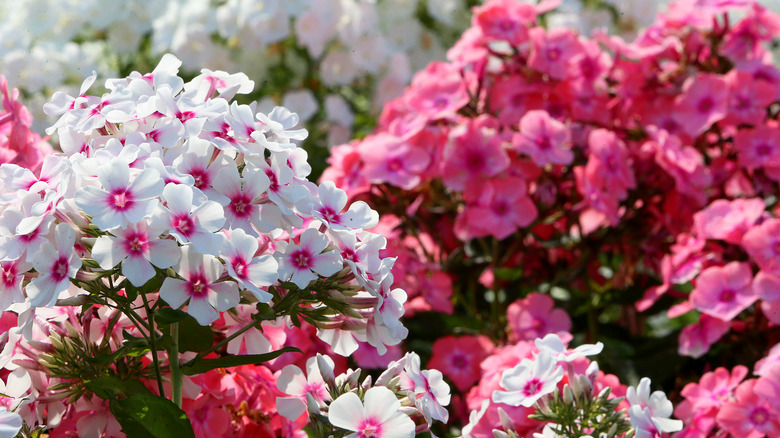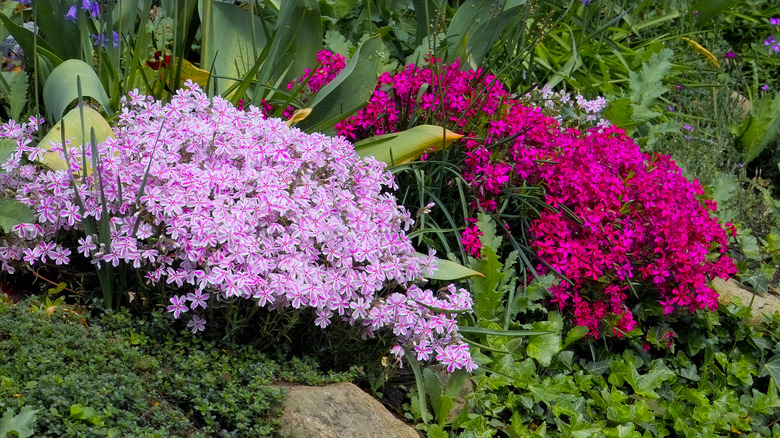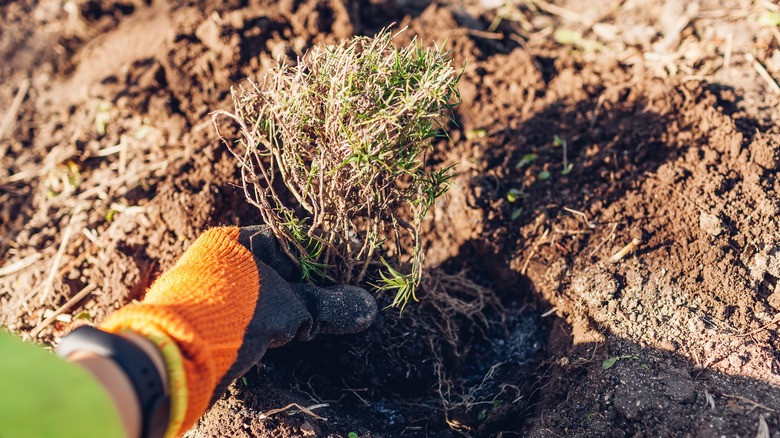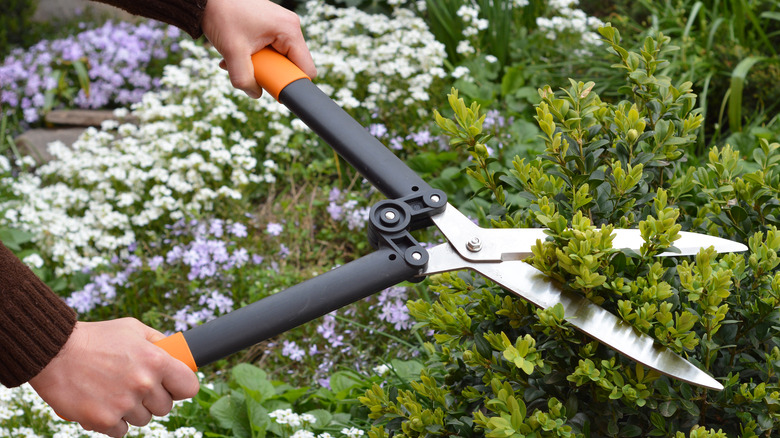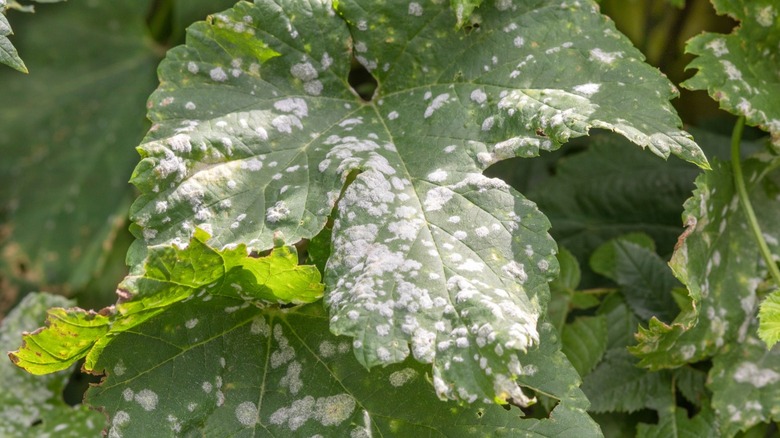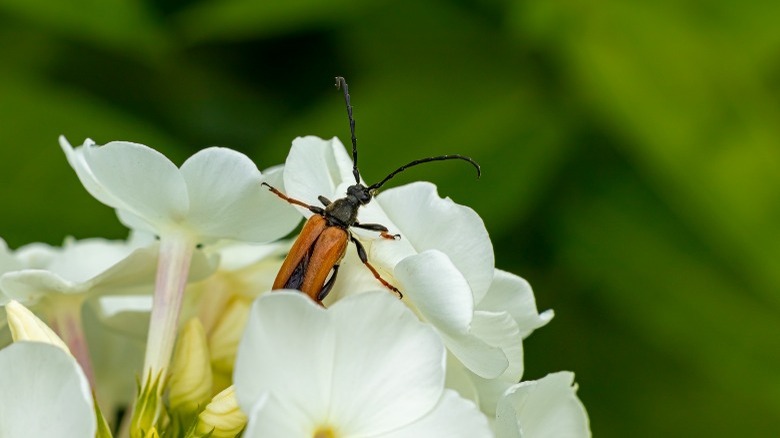How To Successfully Grow A Creeping Phlox Plant
Creeping phlox (Phlox stolonifera) — commonly known as moss pink, moss phlox, or mountain phlox — is a must-have perennial plant for rock gardens thanks to its eye-catching flowers. The semi-evergreen plant is a member of the Polemoniaceae family and blooms in the spring. As Clemson University mentions, the plant is native to the United States and, because it requires little maintenance, provides excellent ground cover for large expanses of land.
Besides covering your yard in a bright blanket of flowers (thanks to its ability to spread quickly), creeping phlox can also be used as a garden border. The spreading phlox is a relatively simple plant to grow, as it thrives in any soil. It also tolerates hot and dry conditions, and can withstand shade (even though it thrives more in full sun). It is also relatively pest- and disease-free. All of these factors make creeping phlox an easy addition to your garden. Read on to learn more.
How to use creeping phlox
No matter the region, this flower offers a lot of color to your environment. Creeping phlox colors include red, white, blue, pink, purple, and lavender. The flowers have a simple design, a pleasant scent, and grow tight together. Because tulips and carnations tower over it, it pairs beautifully with them. Starting in the middle of spring, the creeping phlox bloom lasts three to four weeks. In addition, the plant attracts butterflies and hummingbirds, so your yard will be a hive of activity in the spring.
As TN Nursery notes, the medicinal potential of many phlox species was recognized by Native American civilizations, with certain parts or complete sections being used to cure different health ailments, including cold symptoms, eye irritation, and eczema. As a note, the uses mentioned above are attributed to the Polemoniaceae family as a whole, rather than specific species. So, before using the creeping phlox seeds or other parts, it's best to consult your doctor.
How to grow creeping phlox
In general, creeping phlox doesn't take much attention, Pop Creep notes. When planting it, find a sunny spot in your garden to enjoy the brightly colored blossoms throughout the spring (partially shaded areas will suffice if need be). Except for during the summer, the flower does not require a lot of moisture (although, you should still water it regularly). Furthermore, fertilize the soil once a year during the spring.
The flower covers the ground and can expand across an extensive area, so you might want to prune the stems to keep the look clean. The creeping phlox's lovely floral cover looks beautiful on hills and uneven ground. If you have a rock garden, you can also use it to fill in the blank spaces. However, be aware that weeds and other plants may develop in the same area with the creeping phlox, potentially distracting from the overall aesthetic of the plant. The best way to deal with this is to pull the weeds by hand, ensuring you get the root.
How to care for the creeping phlox
The number-one creeping phlox care tip is to water the plant regularly, especially in the summer. Because it's important to keep the soil moist for its health, you can mulch the area to save some water. Ideally, you should fertilize it after planting. You can also feed the plant sparingly before the blooming season begins.
According to Wilson Bros Garden, some gardeners feed the plants in the early spring to encourage new growth and heavier flowering. To keep creeping phlox in winter, you can grow them in a greenhouse with slightly acidic, well-draining soil. Place the plants where they will get access to full sun or light exposure for at least six hours each day to stimulate robust blooms.
In terms of propagation, you should do it in early spring by simply digging up a clump of the plant, separating the roots, and replanting it. Creeping phlox seeds will usually revert to the wild-species colors and behavior after a few generations in the garden. Therefore, you should remove self-sown seedlings if keeping a specific hue is important to you.
Creeping phlox varieties
Happy DIY Home mentions that creeping phlox, which is native to North America and has dozens of varieties, is a garden center favorite. Some of the most popular species are below:
-
Angelina Phlox (Phlox Paparazzi Angelina): This long-flowering hybrid can reach a height of 8 inches and a width of 12 inches. Its lavender-pink flowers bloom for weeks in the spring and early summer.
-
Candy Stripe Phlox (Phlox subulata Candystripe): As the name suggests, this creeping phlox variety consists of white flowers with pink stripes. It grows 6 inches tall and is fantastic for brightening slopes and rock gardens.
-
Drummond's Pink Phlox (Phlox subulata Drummond's Pink): The vivid pink flowers of this creeping phlox variety provide a stunning contrast to the plant's dark foliage. Reaching up to 6 inches tall, gardeners consider it a lovely companion to spring-flowering bulbs.
-
Jagger Phlox (Phlox Paparazzi Jagger): Jagger is a new breed of creeping phlox. Its purple flowers bloom in the spring and continue into the summer. If you're looking for a creeping phlox that grows a little higher, this variety grows up to 12 inches in height and width, and has a mounded appearance.
- Ronsdorfer Beauty Phlox (Phlox subulata Ronsdorfer Beauty): This variety of creeping phlox is a tiny shrub but is covered in beautiful pink blossoms with a crimson eye in the spring. The plant's charm continues past its blooming season as, when the plant is not in flower, the lime-green, needle-like leaves bring interest and color.
Is creeping phlox toxic?
It's normal to worry about whether a plant is poisonous, especially if you have small children or animals. As Plant Addicts mentions, the creeping phlox is not harmful to humans, dogs, or cats. Therefore, it is a non-toxic plant that is suitable for gardens where there are children and pets. It is also non-toxic to agricultural animals and wildlife. Because this evergreen perennial isn't detrimental, it shouldn't harm children or animals if they chew on the leaves or blossoms.
At most, eating a very large quantity of phlox may cause an upset stomach. However, for your own peace of mind, being cautious is always a good choice when it comes to children and pets. Be sure to purchase the creeping phlox from a commercial nursery to ensure you're buying the proper plant. Also, putting up fences or other barriers prevent children, pets, and outside animals from getting close enough to eat the plant.
How to transplant creeping phlox
To transplant your creeping phlox, make sure the ground area you're going to use is well-drained, and large and deep enough to hold the roots. Once you've decided where you want to plant your creeping phlox, dig a large hole. It should be at least 2 feet wide and 1 foot deep. You can extend or deepen the hole after checking the transplanted phlox's root system.
When you have the hole for the transplanted phlox ready, clear a broad trench around the roots of the original phlox plant using a sturdy shovel and dig deep enough into the dirt to remove the roots out of the ground. To completely uproot your phlox plant, use the tip of your shovel. Hunker recommends dividing the phlox plant by cutting them into several sections, essentially creating separate plants. Be sure that the roots are intact and attached to the foliage of each plant. Return to the place where the phlox will be transplanted, and, if necessary, deepen the hole to a few inches deeper than the original root depth. Carefully set the phlox plant in its hole, making sure that the roots are spread out. Lastly, fill the hole with soil and water the phlox.
How to prune a creeping phlox
Trimming and pruning creeping phlox will prevent the plants from overgrowing and keep them looking tidy. Pruning is also important because overcrowding can lead to diseases such as powdery mildew, due to insufficient air circulation. The summer is the best time to cut back the flowering stems. You can repeat this process once a month to extend the flowering season and promote bloom production. When more than half of your plant's blossoms have perished, it's time to clip dead flowers and trim the stems.
As Horticulture advises, cut back the plant by between one third to one half. You can eyeball this, but if you're unsure, then feel free to measure with a ruler. New growth makes up the top layer of creeping phlox, so look beneath the green layer to get to the dying foliage. Be sure to trim the entire plant to ensure the plant blooms evenly next year.
Common diseases of the creeping phlox plant
According to The Connecticut Agricultural Experiment Station, the phlox plant is susceptible to quite a few diseases. First, there are diseases caused by the fungi family, like powdery mildew and leaf spot disease. Of all the diseases phlox is vulnerable to, powdery mildew is the one to worry about most. One thing you can do as a preventative measure is to space the plants further apart to avoid overcrowding and use fertilizer to strengthen the plant. Watch for symptoms of the disease. It will look like a mealy, white substance on leaf surfaces and stems, mainly on the lower portion of the plant. If you start to see any affected leaves, remove them and put them in a Ziploc bag to prevent spreading the spores to other plants. Fungicide isn't typically needed but can be used as soon as clear symptoms appear.
Leaf spot shows as dark brown circles with white or gray centers. Like powdery mildew, leaf spot starts near the lower portion of the plant, and you should remove affected leaves immediately. Phlox is also susceptible to bulb and stem nematodes, parasitic worms that can do extensive damage and cause deformities of the entire plant, including not flowering, in most cases. The really scary thing about this disease is that it spreads from inside the plant, and comes from infected soil or other infected plants. It can be transmitted through water, animals, gardening tools, or can even be in the seed. Removing infected plants immediately is the only remedy. Lastly, there's leaf blight, but luckily this disease is not easily spread and is much less common. Symptoms are dead or dying leaves near the bottom of the plant; remove them promptly.
Common pests of creeping phlox
Missouri Botanical Garden tells us that the main pest of the phlox plant is the phlox bug, or Lopidea davisi. This piercing insect is the biggest threat to any phlox plant. It is very distinctive in appearance with its long, bright, red-orange body, but it hides underneath leaves. You can see symptoms of this bug's feeding in white or light green spots on the leaves and buds, sometimes with yellow stippling. Ultimately the leaves will turn brown, and these bugs can kill the entire plant. They feed on all parts of the plant, including the seeds. You can control the bugs by using insecticidal soap and then using a light horticultural oil. Only use insecticide if the problem gets out of control.
According to Epic Gardening, spider mites, as well as aphids, are extremely common pests of both mounding tall and creeping phlox plants. Unfortunately, these two pests are both incredibly tenacious, and the best way to avoid them is to prevent them in the first place! A good coating of neem oil on all plant surfaces, including the leaves' undersides, works for both pests and won't harm your plants. Keeping the area around your plants free of debris and other pests like slugs or snails is also a key to maintaining healthy phlox and other plants.
